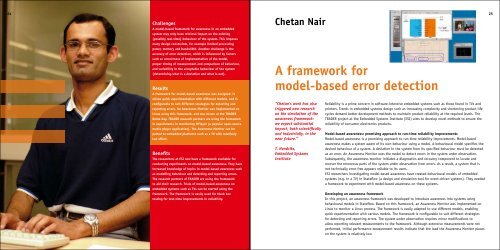Software Technology - Stan Ackermans Institute - TU/e
Software Technology - Stan Ackermans Institute - TU/e
Software Technology - Stan Ackermans Institute - TU/e
You also want an ePaper? Increase the reach of your titles
YUMPU automatically turns print PDFs into web optimized ePapers that Google loves.
24<br />
Challenges<br />
A model-based framework for awareness in an embedded<br />
system may only have minimal impact on the existing<br />
(possibly real-time) behaviour of the system. This imposes<br />
many design constraints, for example limited processing<br />
power, memory and bandwidth. Another challenge is the<br />
accuracy of error detection, which is influenced by factors<br />
such as correctness of implementation of the model,<br />
proper timing of measurement and comparison of behaviour,<br />
and variability in the acceptable behaviour of the system<br />
(determining what is a deviation and what is not).<br />
Results<br />
A framework for model-based awareness was designed. It<br />
allows quick experimentation with different models, and is<br />
configurable to suit different strategies for detecting and<br />
reporting errors. An Awareness Monitor was implemented on<br />
Linux using this framework, and was shown at the TRADER<br />
Demo Day. TRADER research partners are using the framework<br />
in experiments in monitoring MPlayer (a popular open-source<br />
media player application). The Awareness Monitor can be<br />
ported to embedded platforms such as a TV with relatively<br />
low effort.<br />
Benefits<br />
The researchers at ESI now have a framework available for<br />
conducting experiments on model-based awareness. They have<br />
increased knowledge of topics in model-based awareness such<br />
as modelling behaviour and detecting and reporting errors.<br />
The research partners of TRADER are using the framework<br />
to aid their research. Trials of model-based awareness on<br />
embedded systems such as TVs can be started using the<br />
framework. The framework is easily used for black box<br />
testing for test-time improvements in reliability.<br />
Chetan Nair<br />
A framework for<br />
model-based error detection<br />
“Chetan’s work has also<br />
triggered new research<br />
on the simulation of the<br />
awareness framework:<br />
we expect substantial<br />
impact, both scientifically<br />
and industrially, in the<br />
near future.”<br />
T. Hendriks,<br />
Embedded Systems<br />
<strong>Institute</strong><br />
Reliability is a prime concern in software-intensive embedded systems such as those found in TVs and<br />
printers. Trends in embedded systems design such as increasing complexity and shortening product life<br />
cycles demand better development methods to maintain product reliability at the required levels. The<br />
TRADER project at the Embedded Systems <strong>Institute</strong> (ESI) aims to develop novel methods to ensure the<br />
reliability of consumer electronics products.<br />
Model-based awareness: promising approach to run-time reliability improvements<br />
Model-based awareness is a promising approach to run-time reliability improvements. Model-based<br />
awareness makes a system aware of its own behaviour using a model. A behavioural model specifies the<br />
desired behaviour of a system. A deviation in the system from its specified behaviour must be detected<br />
as an error. An Awareness Monitor uses the model to detect errors in the system under observation.<br />
Subsequently, the awareness monitor initiates a diagnostics and recovery component to locate and<br />
recover the erroneous parts of the system under observation from errors. As a result, a system that is<br />
not technically error-free appears reliable to its users.<br />
ESI researchers investigating model-based awareness have created behavioural models of embedded<br />
systems (e.g. in a TV) in Stateflow (a design and simulation tool for event-driven systems). They needed<br />
a framework to experiment with model-based awareness on these systems.<br />
Developing an awareness framework<br />
In this project, an awareness framework was developed to introduce awareness into systems using<br />
behavioural models in Stateflow. Based on this framework, an Awareness Monitor was implemented on<br />
Linux to monitor a Linux process. The framework is easily adapted to use different models, enabling<br />
quick experimentation with various models. The framework is configurable to suit different strategies<br />
for detecting and reporting errors. The system under observation requires minor modifications to<br />
allow reporting relevant measurements to the framework. Although extensive measurements were not<br />
performed, initial performance measurement results indicate that the load the Awareness Monitor places<br />
on the system is relatively low.<br />
25



